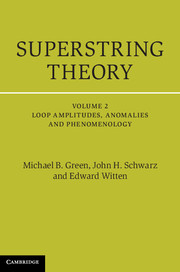Book contents
- Frontmatter
- Contents
- Preface to the 25th Anniversary Edition
- 8 One-loop diagrams in the bosonic string theory
- 9 One-loop diagrams in superstring theory
- 10 The gauge anomaly in type I superstring theory
- 11 Functional methods in the light-cone gauge
- 12 Some differential geometry
- 13 Low-energy effective action
- 14 Compactification of higher dimensions
- 15 Some algebraic geometry
- 16 Models of low-energy supersymmetry
- Bibliography
- References
- String Field Theory
- Index
14 - Compactification of higher dimensions
Published online by Cambridge University Press: 05 September 2012
- Frontmatter
- Contents
- Preface to the 25th Anniversary Edition
- 8 One-loop diagrams in the bosonic string theory
- 9 One-loop diagrams in superstring theory
- 10 The gauge anomaly in type I superstring theory
- 11 Functional methods in the light-cone gauge
- 12 Some differential geometry
- 13 Low-energy effective action
- 14 Compactification of higher dimensions
- 15 Some algebraic geometry
- 16 Models of low-energy supersymmetry
- Bibliography
- References
- String Field Theory
- Index
Summary
Since superstring theories are necessarily ten-dimensional theories, any discussion of phenomenology must begin with a discussion of how apparent four-dimensional physics is related to underlying ten-dimensional physics. The present chapter is devoted to this question. We will carry out the discussion in the context of field theory, but with an emphasis on properties that depend only on qualitative assumptions, not numerical details, and so can remain valid in string theory. What we will try to accomplish in this chapter is not to develop detailed models of compactification but to set the stage and introduce some of the essential concepts.
Wave Operators in Ten Dimensions
Most of the preceding chapters have been devoted to string propagation in ten-dimensional flat Minkowski space M10, but henceforth we will consider ten-dimensional space-time to be some more general ten manifold M. We take M to be of the form M4 × K, where M4 is four-dimensional Minkowski space and K is a compact six manifold which is, unfortunately, as yet unknown. More precisely, we take the vacuum state to be a product M4 × K; it must have this form if we wish to maintain four-dimensional Poincaré invariance. Of course, physical fluctuations will not necessarily respect the product form of the vacuum configuration, but as in so many other areas of physics, understanding the ground state is the key to understanding the low-energy excitations.
- Type
- Chapter
- Information
- Superstring Theory25th Anniversary Edition, pp. 363 - 412Publisher: Cambridge University PressPrint publication year: 2012



